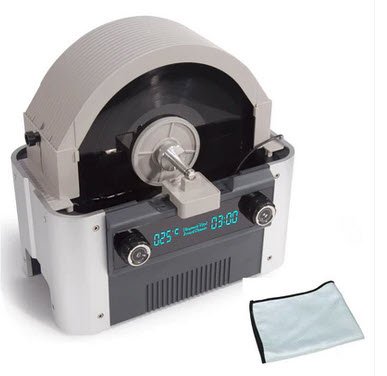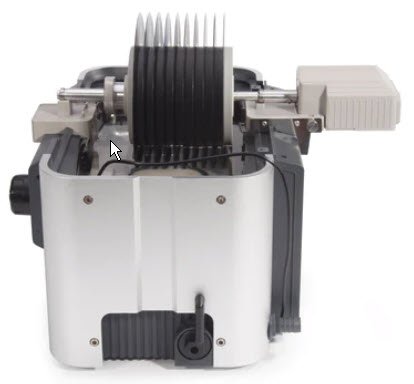Confirming the broad acceptance of ultrasonic record cleaning, another desktop model appears in the marketplace. Here is the CS6.1-PRO from iSonic. This one is different from the current crop of slotted desktop cleaners.


Here is a $999 compact (12.2"x6.8"x4.6"), 1.55 gallon, open-top machine described as capable of cleaning 10 records while offering max 600rpm spin drying. Both 220-240V and 100-120V offerings. It includes a 1 micron filter and supports cleaning of both 33? and 45 records. It appears to have a heater, thermometer and a timer. Empty the tank to run the spin-dry. Im guessing the shield over the records in the above picture is put in place for drying, so it doesn't fling water everywhere. The shield comes off for loading.
If width is 6.8" that means around ~1/2" between records which imo is too short-spaced to support 10 simultaneously. Records are 'protected' with a silicon coated gasket covering their labels, so my guess is the water line may come over the label. (I prefer a water line that just touches the run-out groove but does not cover it.) It does not appear to have spacers to increase the distance between records other than using the silicon coated gaskets. Practically it may support cleaning 4-5 records at a time, which is fine.
iSonic does not tell us an ultrasonic frequency. We don't know how many ultrasonic transducers it has, but 80 Watts of power seems very low for effective cleaning. For comparison, the Elmasonic P120 provides 330 W nominal power with a 1320 W peak.
An ergonomic factor to consider is loading, handling and unloading a spindles-worth of records. It is not clear if there is any provision to mount or hold the spindle, which may mean you hold it in your hand -- not clear how that works.
The CS6.1-PRO does accommodate rinsing which is good thing, but you will go through a fair amount of water. Granted that distilled water is cheap, just be prepared to haul several jugs from the grocery store. Yes, you could try to re-use the rinse water, but I cannot recommend doing so. Surfactant is included though formulary is unspecified other than saying it does not contain sulfuric acid, phosphorus and ammonia. Absent a reason not to use it, Tergitol 15-S-9 is my recommended cleaner.
This machine does not provide the convenience of today's single-slot machines (Klaudio, Degritter, AudioDesk). More records does mean more work. It does seem headed in the right direction and is less than half the price of those cleaners.
If you use an iSonic CS6.1-PRO it will be great to hear your thoughts about using it.

 isonicinc.com
isonicinc.com


Here is a $999 compact (12.2"x6.8"x4.6"), 1.55 gallon, open-top machine described as capable of cleaning 10 records while offering max 600rpm spin drying. Both 220-240V and 100-120V offerings. It includes a 1 micron filter and supports cleaning of both 33? and 45 records. It appears to have a heater, thermometer and a timer. Empty the tank to run the spin-dry. Im guessing the shield over the records in the above picture is put in place for drying, so it doesn't fling water everywhere. The shield comes off for loading.
If width is 6.8" that means around ~1/2" between records which imo is too short-spaced to support 10 simultaneously. Records are 'protected' with a silicon coated gasket covering their labels, so my guess is the water line may come over the label. (I prefer a water line that just touches the run-out groove but does not cover it.) It does not appear to have spacers to increase the distance between records other than using the silicon coated gaskets. Practically it may support cleaning 4-5 records at a time, which is fine.
iSonic does not tell us an ultrasonic frequency. We don't know how many ultrasonic transducers it has, but 80 Watts of power seems very low for effective cleaning. For comparison, the Elmasonic P120 provides 330 W nominal power with a 1320 W peak.
An ergonomic factor to consider is loading, handling and unloading a spindles-worth of records. It is not clear if there is any provision to mount or hold the spindle, which may mean you hold it in your hand -- not clear how that works.
The CS6.1-PRO does accommodate rinsing which is good thing, but you will go through a fair amount of water. Granted that distilled water is cheap, just be prepared to haul several jugs from the grocery store. Yes, you could try to re-use the rinse water, but I cannot recommend doing so. Surfactant is included though formulary is unspecified other than saying it does not contain sulfuric acid, phosphorus and ammonia. Absent a reason not to use it, Tergitol 15-S-9 is my recommended cleaner.
This machine does not provide the convenience of today's single-slot machines (Klaudio, Degritter, AudioDesk). More records does mean more work. It does seem headed in the right direction and is less than half the price of those cleaners.
If you use an iSonic CS6.1-PRO it will be great to hear your thoughts about using it.

CS6.1-PRO | iSonic® Motorized Ultrasonic Vinyl Record Cleaner for 10 R
iSonic® CS6.1-Pro Motorized Ultrasonic Vinyl Record Cleaner for 10 Records, with Filter and Spin Drying, 1.6 Gal/6L, 110V The new model is specifically designed vinyl record cleaning based on what we've learned from the successes of the previous models in the last few years. It's fitted with a...




